Teeth of the Dog, Casa de Campo, Dominican Republic
by Bryan Izatt
April, 2005
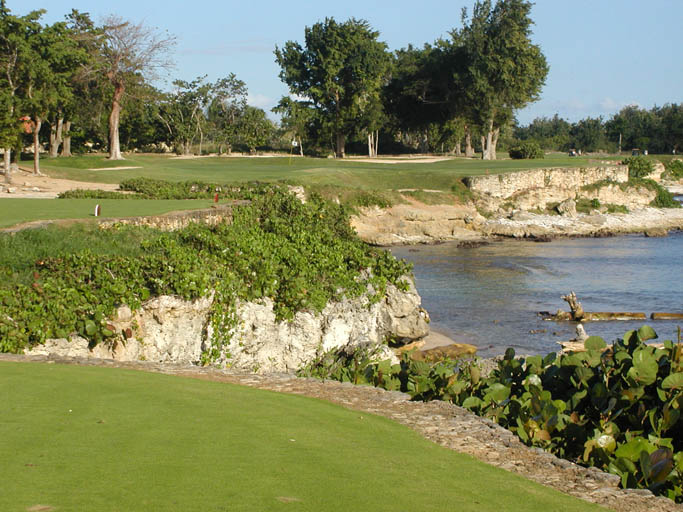
It is easy to be distracted from your game by the beauty of the surroundings at The Teeth of the Dog.
Like a few others, Pebble Beach, Bandon Dunes, Kiawah, and Turnberry, for example, Casa de Campo in the Dominican Republic offers a first class resort by the sea with a world class golf course in the Teeth of the Dog. Built by Pete Dye in the early 1970’s on the coral cliffs of the southern Caribbean coast of the Dominican, The Teeth of the Dog is a seaside course that offers fine strategic challenges with tropical weather and beautiful vistas that can’t be beat.
Although sometimes described as a links course, since it was built following Dye’s journey to Scotland, it could more accurately be described as a tropical parkland course on the edge of the sea. It does not really have the attributes of the true Scottish links courses.
Like some of Dye’s early work, the course presents a risk/reward approach to course architecture: the more you gamble with a hazard, especially on the ocean holes, off the tee, the easier the second shot. Like many of his courses, it looks more difficult than it actually plays although with a rating/slope of 74.1/140 from the tips, it is no pushover. The course is somewhat easier to play now than it was 10 to 15 years ago because of the improvements in club and ball technology. It plays relatively shorter than the 6989 yards from the tips, due to the firm and fast conditions of the fairways. However, par is well defended by wonderfully difficult green complexes, deception, and the visual intimidation of the ocean on many holes.
Unlike many of Dye’s courses, it doesn’t use railroad ties as bulkheads, nor is it obviously imposed on the landscape like the TPC at Sawgrass or PGA West. It is much more lay of the land, probably owing at least partially to the underlying coral rock on which the course is built. The one exception is that many of the tees are built on pedestals that are clearly man-made. They are tastefully done using the coral rock found on the course.
The course has a butterfly routing, clockwise on the front nine and counter-clockwise on the back, which varies the impact of the constant trade winds from hole to hole. The wind generally blows towards the ocean and quarters toward the northwest, and seems to almost always be a one to two club wind.
The conditioning of the course is not at the standard of private US courses, but is better than average for tropical courses, and in no way detracts from the golf experience or fairness or challenge of the course.
Hole 1: Par 4, 393 yards (all yardages from the Gold Tees)

The first hole appears to be a welcoming opening hole, but is not as easy as it looks. It plays downhill, is relatively short, and generally has a left to right wind. However, there are deep grass swales on the right which is the direction the wind is blowing and the direction in which the fairway falls. The green is very unreceptive to shots from the right side as well. The green is much more easily approached from the left side of the fairway just inside the two fairway bunkers.
The green complex is the main defence of the hole. Like most greens on the course, it is relatively small, and is made smaller by a severe false front and a run-off on the back left. The bunkers are also tight to the green and fairly deep. The first is a hard green to get close to the pin if you’re coming from the wrong side.
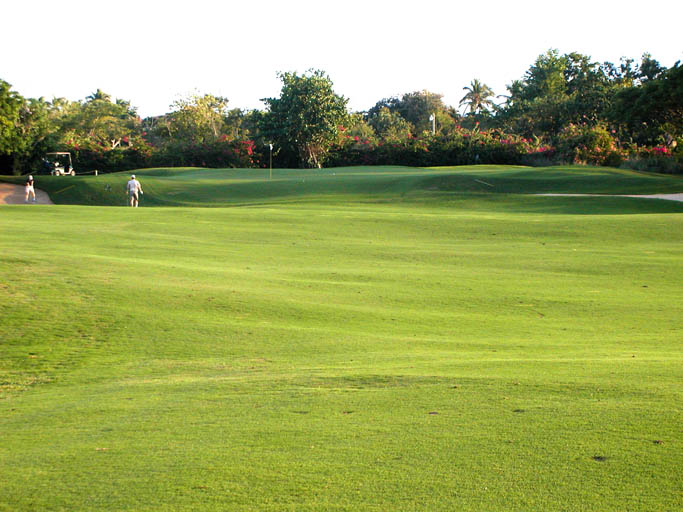
Hole 2: Par 4, 384 yards
The second is a visually intimidating hole off the tee. The fairway appears narrow from the tee and is offset to the right. The hole plays partially into the wind, which is also blowing from left to right. The hole sets up for a draw off the tee. A wind assisted fade can easily find the trees on the right. Anything in the rock filled waste area to the left may be dead or may bounce back into the fairway.
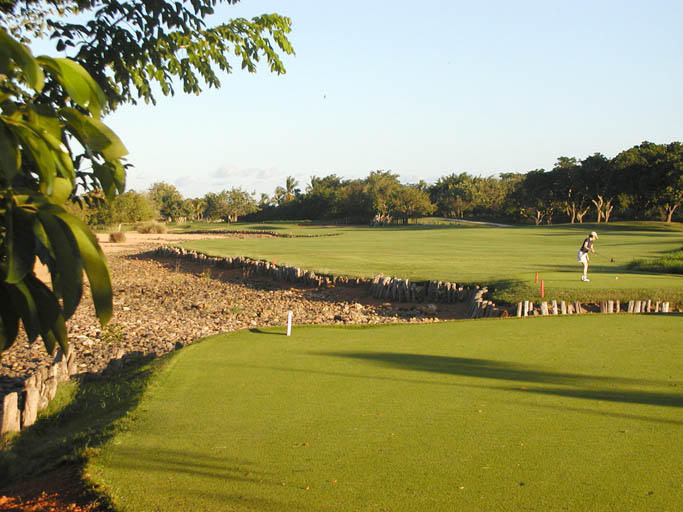
The green is angled left to right and is full of undulations, has a false front and run-off areas. Like the first it is best approached from the left side of the fairway. Playing to the left side of the fairway, of course, flirts with possible O.B. off the rocks in the waste area, or unplayable lies. The second is a fine example of a risk/reward hole where executing the proper strategy off the tee will increase the chances of success.
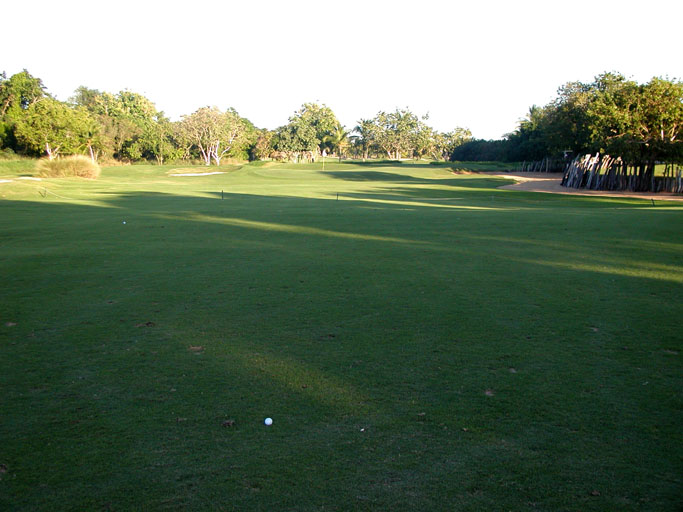
Hole 3: Par 5, 498 yards
The third appears to be an easy par 5 to start off, even though it is uphill and against the prevailing wind. At 457 from the blues, it looks even more enticing. The fairway is generous off the tee, as long as you don’t lose it right – the waste area angles away and is more of a carry into the wind than it appears.
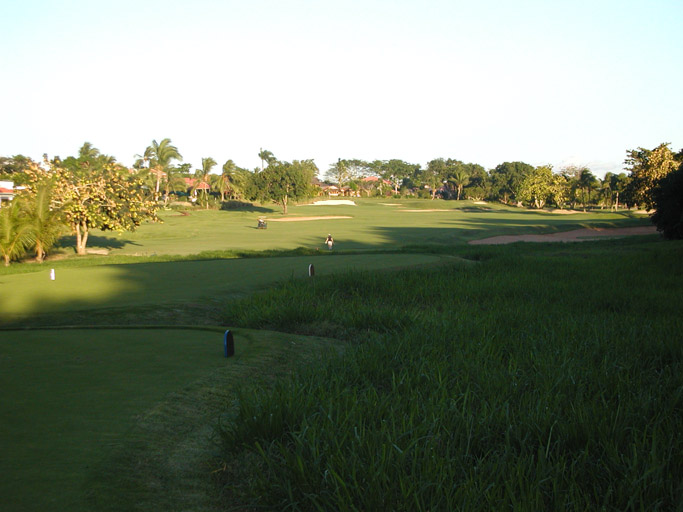
The strategy begins on the second shot. If you drive up to, or slightly past, the fairway bunker left, you will be in range to have a go at the green. However the green is a table top raised 6 to 10 feet above the fronting fairway, and it is extremely narrow and not very deep.
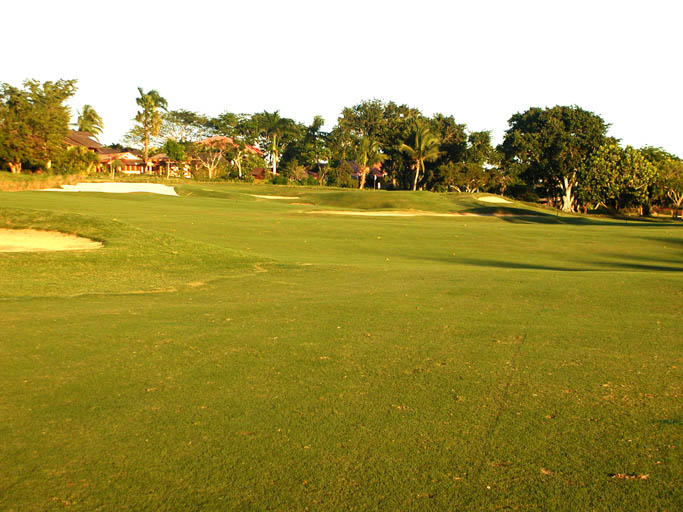
The options are to lay up short of the crossing bunker and leave a full wedge shot to the green; lay up to the right and short of the green where there is a generous landing area, leaving a short chip; or, have a go at the green. A miss left or right, pin high, will generally leave you in a greenside bunker.
The full wedge shot is not so easy, as the green is so narrow when approached from the middle of the fairway. A chip from the landing area to the right is a challenge since it’s to a plateau green and the green target is not only shallow from that side, it also slopes away. If you’re confident in your sand game, a miss pin high in the left trap is probably the best bet. The green is shallow from that side, but it is sloped slightly toward you. The green is relatively flat and offers birdie putts from almost anywhere on the green to any pin position.
Hole 4: Par 4, 364 yards
The fourth hole is probably the least interesting on the course, although for the first time the sea is in view behind and to the right of the green.
From an elevated tee there appears to be acres of land to hit the drive to. The whole right side is rough, though, and offers a more difficult shot across traps to a green that angles away from left to right. Place the tee shot down the left side of the fairway and the green opens up, but beware of the overhanging palm tree just left of the tee.
The fourth tee is usually a good place to pick up some recycled ProV1’s for around a buck apiece from some of the locals who arrive mysteriously from the bushes when you arrive at the tee.
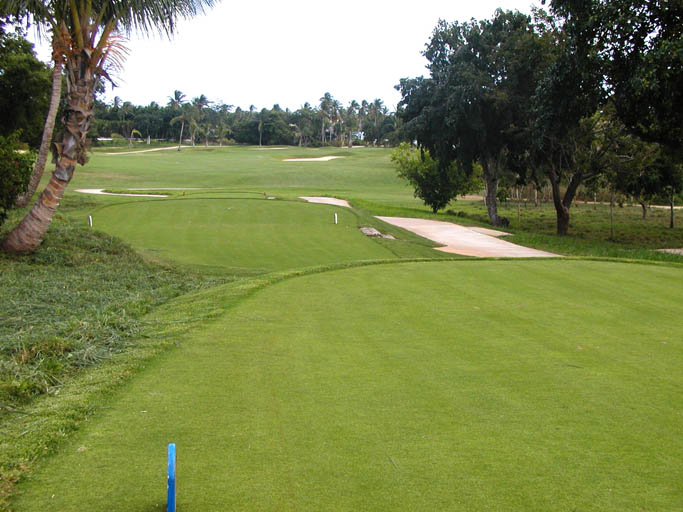
Hole 5: Par 3, 157 yards
On the ocean at last, starting with a shortish par 3 with plenty of pucker power. The wind is usually helping a bit, but is also right to left and out to sea.
The green is quite small, and is made smaller by the crossing wind. There is a small bailout area to the right, but that can leave an awkward shot from a trap to a shallow green that runs away a bit, and has nothing but ocean in your view. A cut shot held against the wind works best.
Some years ago the hole, as originally designed, was harder still. There was a full sized specimen tree where the small tree now stands at the right front corner of the green. It precluded trying to come into the green from the right side and basically took away the bailout area. Unfortunately the tree was lost in a hurricane.
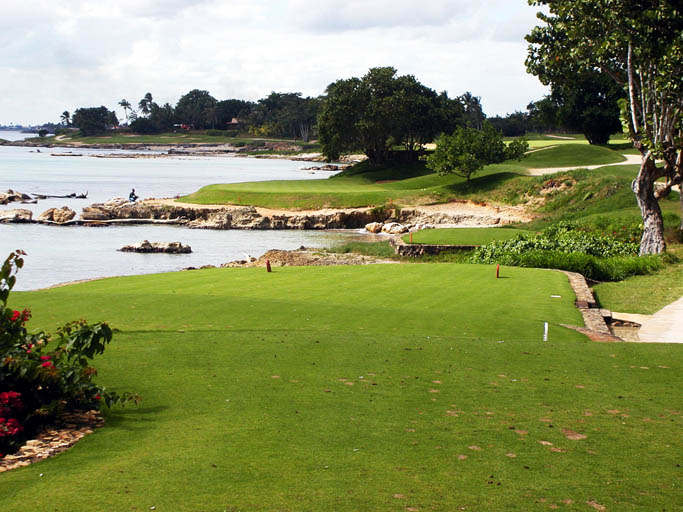
Hole 6: Par 4, 463 yards
The sixth is a long Par 4 right to left cape hole that usually has some wind assistance, especially on the second shot. The tee shot presents the usual risk/reward. Hug the left side over the ocean and you’re rewarded with a shorter second shot. Play safe to the right where there is ample room and you might be too far away to reach the green in two. Worse, you’ll have to hit your long second off a sidehill lie. The temptation is to use the coral retaining wall, over the forward tees, as your target line, but it is a huge carry; a neat piece of Dye deception. A line over the bunker to the right of the wall is much better, and the slope of the fairway will kick the ball left too.
You can also see in the picture, one of the many coral rock pedestal tees used on the course in the process of being enlarged.
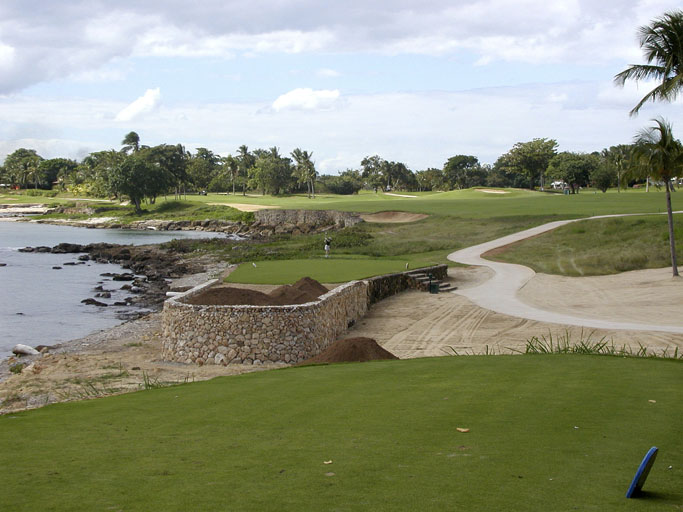
The second shot, with a long iron, can usually be played as a draw, using the slope of the fairway and the prevailing wind to assist. The right front of the green is open and allows the ball to be run up. Given the length of the hole there are no greenside bunkers, just rough swales and slopes.
The green is one of the largest on the course, to match the length of the hole, and is significantly sloped from back right to front left. It also has some undulations to make most putts on this green a challenge.
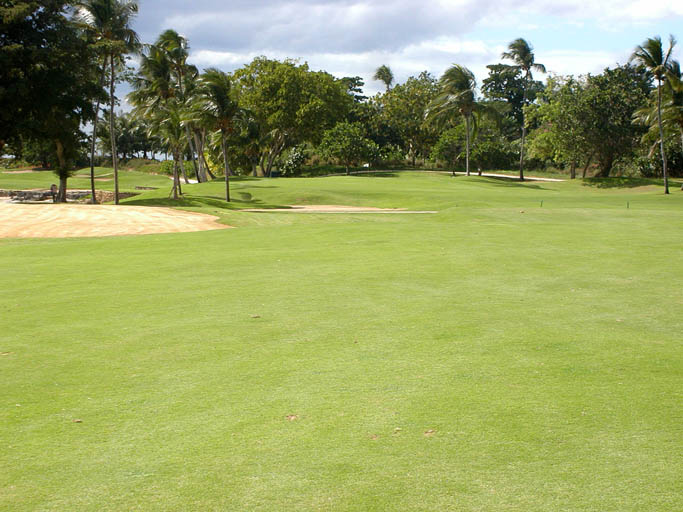
Hole 7: Par 3, 224 yards
The seventh hole is the second of three spectacular seaside par 3’s. It’s long with lots of traps to capture offline shots. The wind is usually helping a bit and blowing out toward the sea side. The green is relatively large but has several tiers to it, so putting is a challenge if you can hit the green.
Pete Dye’s Dominican house is up the hill to the right of the cart path.
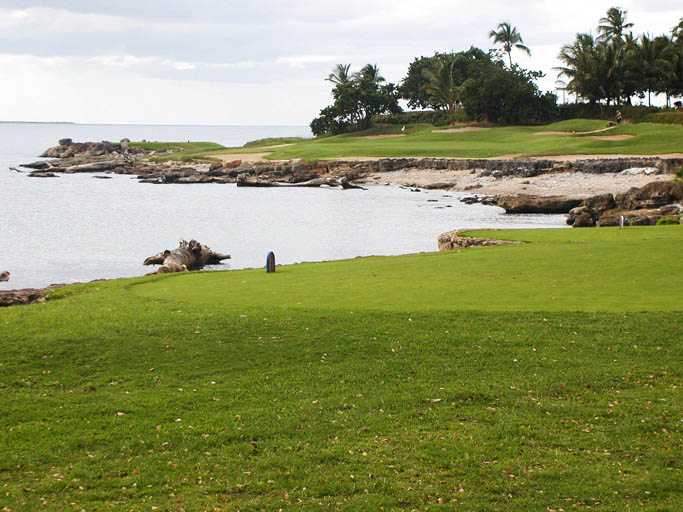
Hole 8: Par 4, 412 yards
The eighth tee presents another intimidating drive. The temptation is to try to cut off part of the ocean to obtain a shorter second shot, but a better line is towards the last trap on the right. The fairway tilts right to left and will usually kick the ball back to the centre of the fairway. Most of the landing area presents uneven lies which make the second shot more interesting.
The green is not visible on the second shot, although the flag is. Generally the line for the second shot is towards the group of palms in front of the wooden fence. It will look like a long way right of the flag, but the green slopes up dramatically to right in front of the palms and will kick the ball left and down to the usual flag positions. Going directly at the flag on the second will be an act of faith that you have the right yardage dialled in. The green is blind, and there appears to be nothing but ocean behind the flag.
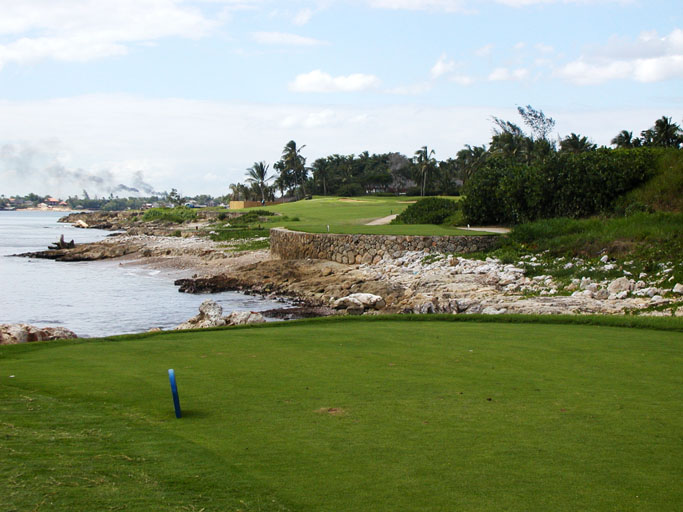
Following is a picture from right and just short of the green. Although you can’t see it, the green extends up the hill towards the palm tree and behind the trap. The slope of that part of the green is too severe for any pin positions, but it does provide a nice ramp to run the ball down to the pin position.
The green is a redan type, sloping to the left rear, with a deep bunker front left, and a deep grass swale on the back right. The putting surface itself is sloped but otherwise relatively benign.
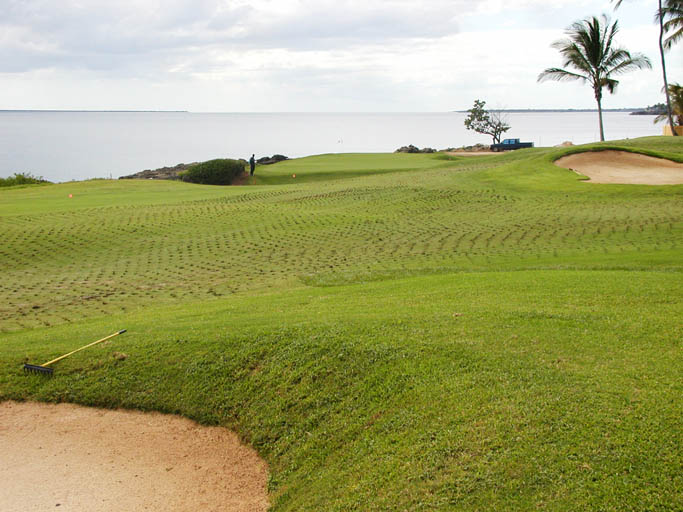
Hole 9: Par 5, 545 yards
The second par 5 of the front nine turns back inland towards the club house and the resort and is essentially an uphill double dog leg. The drive can be played over the right edge of the waste area to shorten the second shot but this is really a hard hole to reach in two as the second shot is uphill to an elevated green and generally plays at least partially against the wind. There’s plenty of room to play to the right on the tee shot and then left on the second to set up a full short shot to the green.
One interesting aspect of this hole is that the area left of the waste area off the tee used to be the end of the runway for the Casa de Campo airport, which has now been closed. The runway used to be in play for those who hooked or pulled the ball at all. It was an experience not too long ago to stand at the end of the runway and see a 737 barrelling down the runway on takeoff.
The runway used to parallel the 10th and 11th hole, and had to be driven across from the 12th and 18th tees. There used to be gates, guards and warning bells to control golfers playing the 12th and 18th when planes were landing or taking off. The only remnant of the runway that has been preserved is in front of the 18th tee.

As the following picture shows, laying up to the left provides more of an opening to approach the green and allows you to play up the length of the green. The right side requires a more difficult shot to an elevated green where you can’t see the surface and requires negotiation of the two traps. Balls that are a little long from this direction will generally run off the green into a swale.

(con’t) Hole 10: Par 4, 396 yards
The back nine begins with an innocuous looking par 4. The green is visible over a vast waste area on the left side, creating a dogleg left. There are acres of room to drive the ball right to avoid the waste area. As usual the best line for the drive is the left side, flirting with the waste area and a slope of rough down to it.
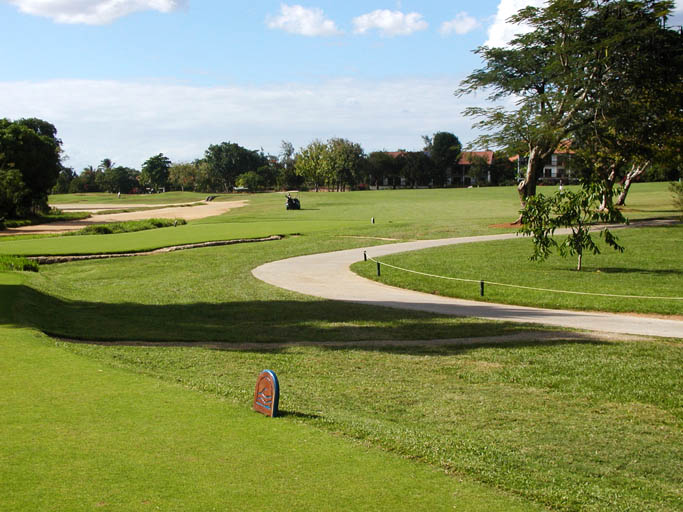
A second shot from the left side will be a short iron to a wedge depending on the wind. From this angle two mounds at the back of the green in the middle and right provide a useful backstop for the wide and shallow green. There is a significant slope from back to front and from right to left. Any ball drawn to the left side of the green is likely to run off the back left of the green, assisted by a helping wind.
Approaching from the right side is a trickier affair. From that side the green is more narrow and long and runs away. With a helping wind it is very hard to keep the approach shot on the green or get near any pin positions on the right. Any balls in the back traps are going to be a difficult up and down as the green runs away in all directions. The front bunkers are a better miss.
The green has a pretty severe slope to it, which makes all putts except those directly below the hole an adventure. Any putts from the right side to the middle and left side are extremely quick as they are downhill, down wind and down grain. All in all, the toughest green on the course.

Hole 11: Par 5, 554 yards
The drive off the eleventh tee is best struck down the middle between the two traps, although a ball hit to the right will probably carry the fairway bunker. A ball left will likely catch the left trap and, worse, the second, will be partially blocked by the large tree behind the trap. A tail wind usually helps on this hole.
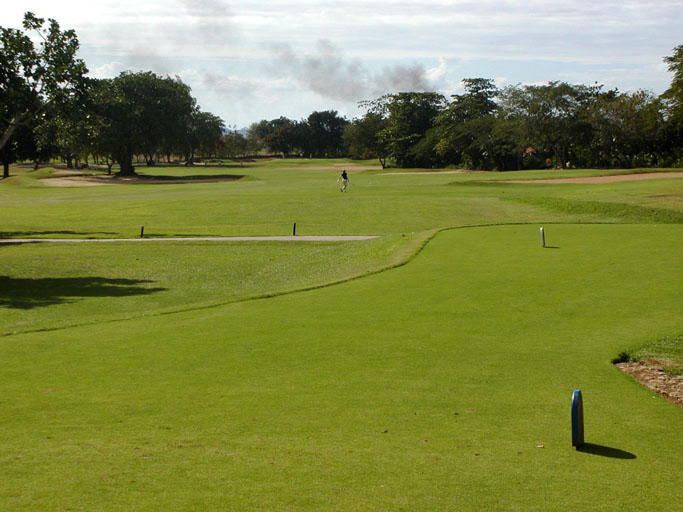
The second shot is best laid up left (where the workers are in the picture) leaving a full wedge shot to the long narrow green. The long hitters will be tempted to go at the green, but the target is very narrow with carry over a large waste area required. There is no possibility to run the ball up; it’s all carry.
The green is pushed up, with a bunker down the entire left side, bunkers front right, and grass swales back right. From either side the green is raised and very shallow. So, accuracy of the third shot is required. The green has some undulation in it making for no easy putts.
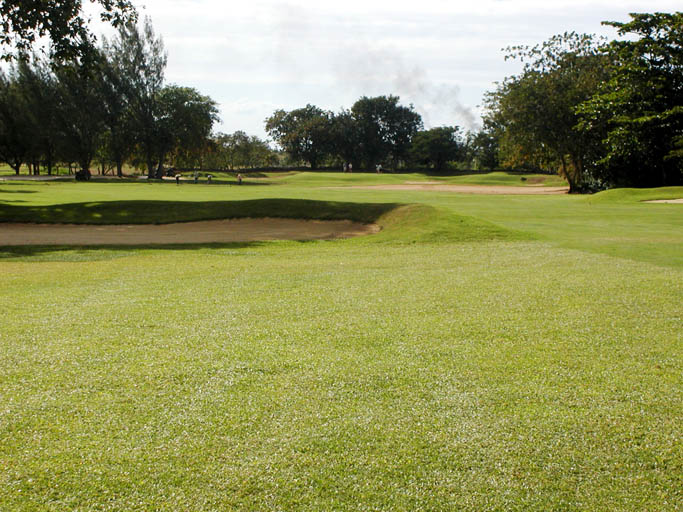
Hole 12: Par 4, 446 yards
The twelfth may be the hardest hole on the course, and used to be one of the quirkiest. The rough area in front of the white tee used to be the runway for the airport, the runway running from right to left across the picture. The runway was crossed at right angles and required a carry of 180 yards or so, pausing, of course, to allow planes as big as a 737 to pass by.
The hole is low profile and the green is not readily visible from the tee. The best line is left centre of the fairway. There is room to the right but it again leaves a longer second shot. The pushup bunkers on the right are a jarring feature, but are no doubt placed there to provide some visual reference of the line not to take.
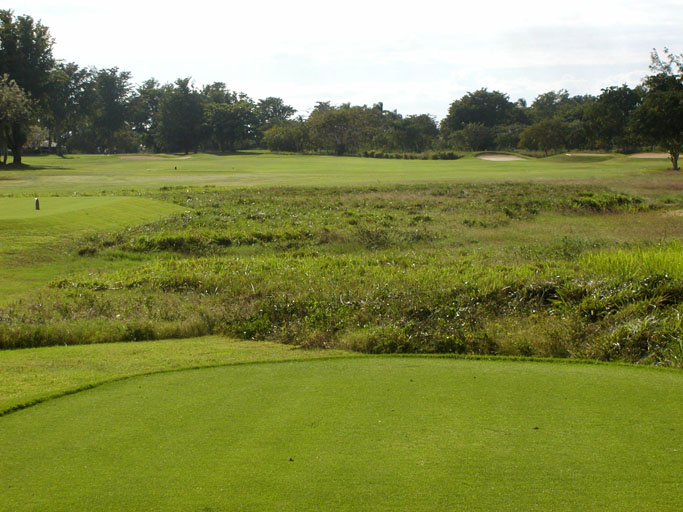
The second shot is a very difficult shot with a medium to long iron. The wind is generally helping a bit, but the green is very low profile, and if played in the afternoon into the sun, is very difficult to discern. Selecting the right club is difficult as there are no visual clues, other the bank of the trap on the front right and around the right side. A generally safe target line is the rest room roof, if you can get the distance dialled in.
The large tree at the left front of the green will knock down any shots pulled left. The green extends back and right further than is evident from the fairway. This is a very difficult green to find with your second shot.
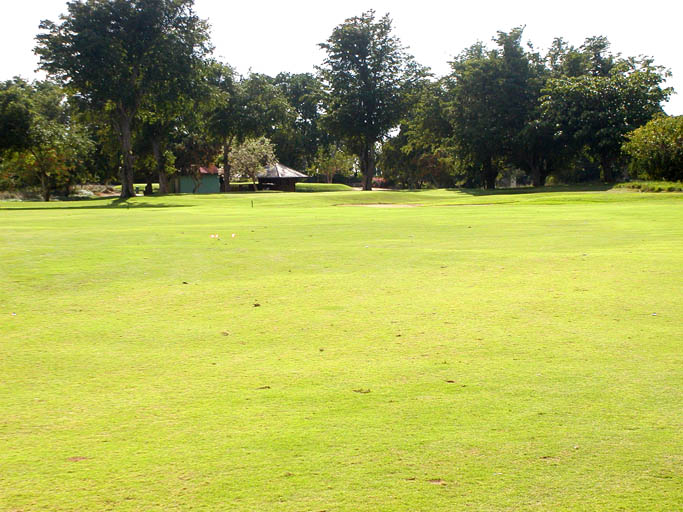
The green has the bunker around the right side, a small grass pit on the left side and runoffs to the back. Depending on pin position there are tough up and downs from all sides. The green itself is narrow in front and swoops down and back to the right presenting many interesting putts.

Hole 13: Par 3, 180 yards
The thirteenth is an island green par 3 in a sea of sand. The green is pushed up so your tee shot must find the green and hold. The wind is generally helping. The middle of the green is its highest point; it runs down to front and down to the back. Tee shots to the front will therefore hold better than those that reach the back half of the green. Putting can be difficult given the slope of the green.
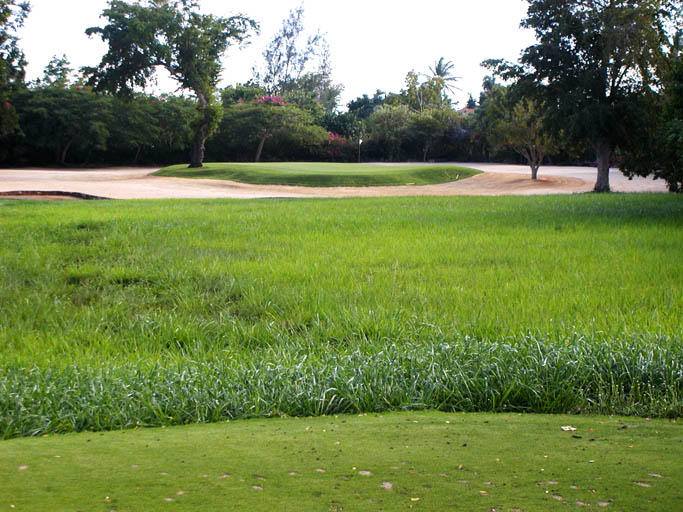
Hole 14: Par 5, 539 yards
On the fourteenth hole you turn around and head back inland, and into the wind, off the tee. This par 5 provides a risk/reward opportunity of going for the green in two (well, at least Fred Couples did on one of the old Shell WWOG episodes) across a pond on this right turning dogleg. The best gambling line is down the right side of the fairway, but the waste area penalizes anyone who leaks the ball a little right. A line down the middle or toward the left bunkers provides a safer line, but means a lay up for the second shot.
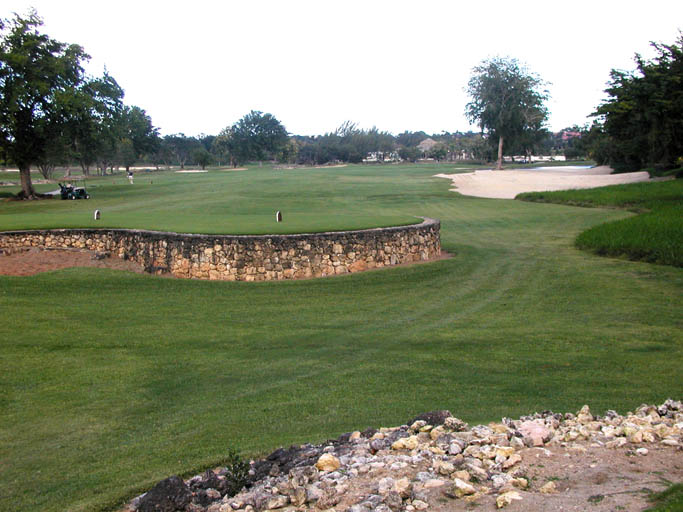
Lay-ups are most safely played to the corner of the dogleg. Trying to bite off part of the pond provides some risk and not much reward – a partial shot from some uneven lies. The green itself is one the less inspiring ones on the course.

It is now time to return to the ocean for holes 15, 16, and 17.
Hole 15: Par 4, 375 yards
The fifteenth hole is a relatively short right swinging cape hole that is generally played into the wind off the tee. The green in the distance appears to perch on a cliff over the ocean.
The tee shot is a lay-up to whatever distance provides a comfortable second shot. A driver off the tee can easily go through the fairway on the left, or has to threaded between the bunkers and the ocean to a very narrow strip of fairway. A line just to the right of the trap visible by the trees is preferred and a fairway wood should be more than enough club. Try to ignore the wind pushing to the right and the large water hazard to the right.
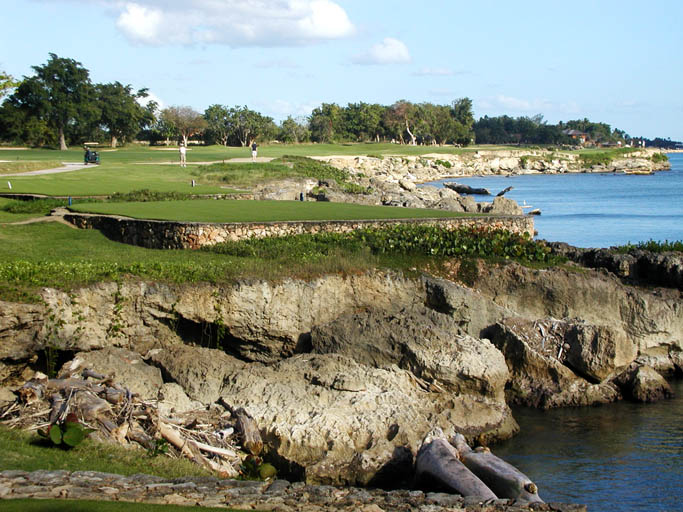
The second shot can be anywhere from a mid iron to a wedge shot depending on the wind. The green sweeps from the traps at the front left, well around to the right out on the peninsula. A shot from the left of the fairway to a front pin is a lot less intimidating than a shot from the right side of the fairway to a right pin position. Despite the skyline green, there is some room over the green and right. Slightly long is not bad; slightly short is dead.
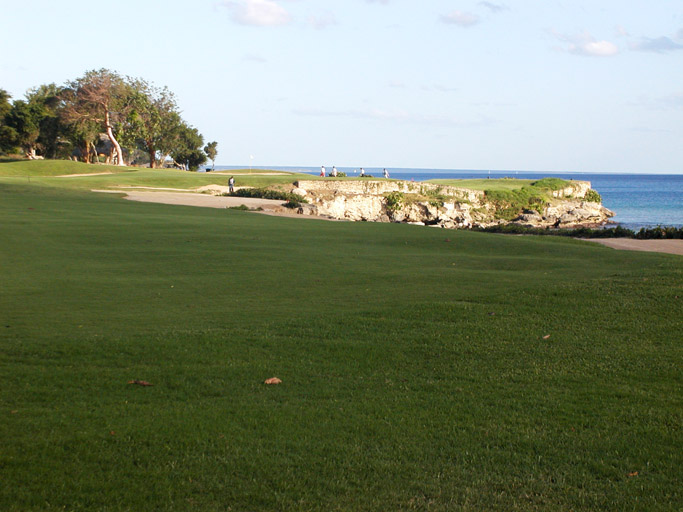
The green is quite contoured and tiered. Balls hit short left will not run up the green as there is a significant rise. The back and right of the green run away – for all appearances right into the ocean. Any shots past the middle of the green are likely to run to the back edge or off the green (but likely not into the ocean). This is some of Dye’s visual intimidation.
Most putts will be entertaining, especially if you’re on the wrong section of the green. The fifteenth is a great short par 4, and very challenging if the wind is up.
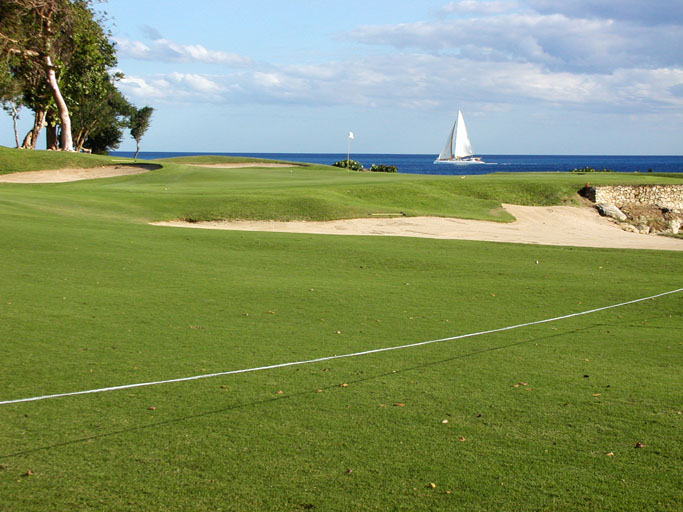
Hole 16: Par 3, 194 yards
The final par 3 on the ocean is probably the most penal of the three. It generally plays into the wind and is relatively long. The trees around the green also cause the wind to swirl, making club selection even more difficult.
The front left pin position is the easiest, and plays to the small bail out area. A pin on the right side of the green over the coral rock wall looks reasonably impossible when you’re standing on the tee with a long iron or fairway wood in your hands. For that pin position, a shot to the middle of the green, like the 12th at Augusta, is recommended.
The green provides generally long sweeping putts and adds some fairness after the difficulty of the tee shot.

Hole 17: Par 4, 429 yards
The last ocean hole is a sweeping dogleg right. Played partially into the wind it is Dye’s second long par 4 of the back nine. The line off the tee is just inside the fairway bunker on the left. Any shot pulled or hooked can make it into the trees or bunkers and make for a very difficult and long second shot. A more risky drive down the right side of the fairway leads to a shorter second shot and opens up the length of the green.
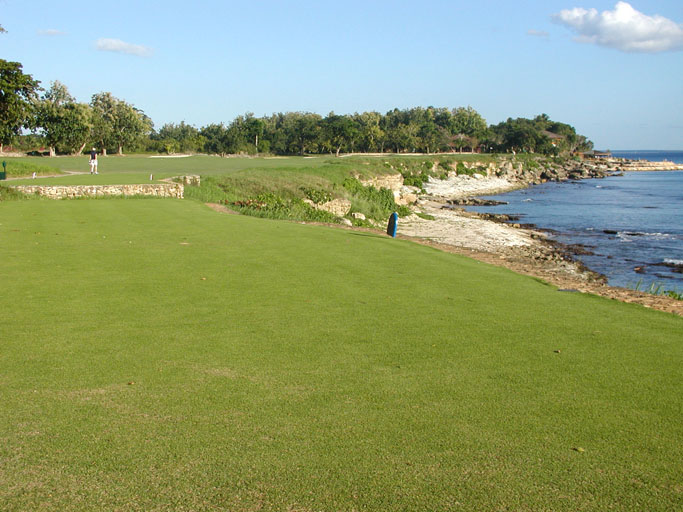
From the right side of the fairway there is a backdrop of trees to provide some depth to the shot. The wind generally is left to right, and care must be taken not to let the approach shot drift off the right side of the green. There is no margin for error to the right of this green.
A shot from the left side will be longer, the wind will be helping the ball more to the right, and the ocean appears to be (and is) lurking just over and to the right. Not a nice shot with a long iron from the left side of the fairway, or worse from the waste areas in the trees or from the bunkers.
There is a significant false front to the green, and the right side runs away slightly towards the ocean. The left green-side bunker provides an intimidating shot that’s down wind to a green running away, with nothing but ocean behind. If you can get on the right part of the green the putts are generally not too difficult – some relief at the end of a difficult hole.
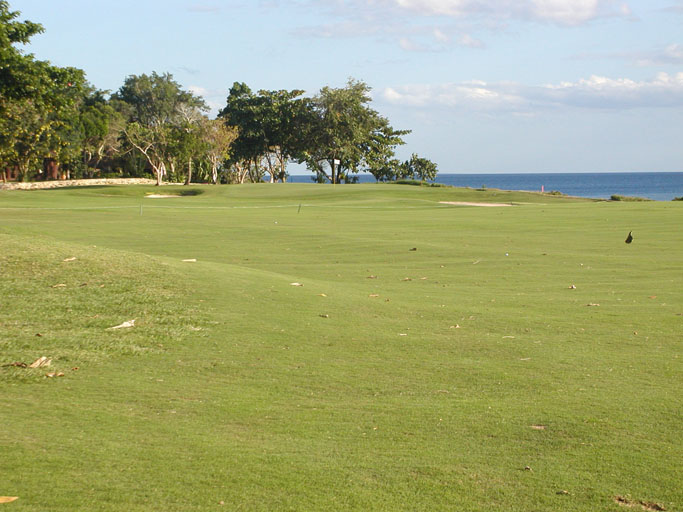
Hole 18: Par 4, 436 yards
Sadly, the eighteenth hole turns inland and away from the ocean and is easily dismissed for that reason. However, the hole provides some subtle, and some obvious challenges, and is actually a fine and difficult closing hole. It plays long since it is usually against the wind, and always uphill on the second. The green is tucked away on top of the hill to the left across a pond and next to the trees.
As you stand on the tee you will notice a concrete road across in front of the tee. This is actually a small piece of the runway for the old La Romana airport that has been preserved for posterity. The old runway presented another visual distraction on the drive on this hole when it was in use.
The fairway is generously wide, but, as usual, there are better and worse places to put your drive. The right side results in a long iron uphill second. Too far right will find the fairway traps and will make reaching the green even more problematic. The left side appears wide open and receptive, but the second shot must carry the pond, uphill, against the wind, and most pin positions are blocked out by the trees around the green encroaching from the left. The centre of the fairway presents the best angle for your second shot.

Good distance control is required for the second shot. The front of the green is quite sloped with balls hit there drawing back off the green. The rear left portion of the green slopes away, resulting in longer shots running through the green. There is a little bit of room back there before you run into one of the resort roads, but not much. Short right looks like a bail out area for the second, but there are a number of traps there that present very difficult long bunker shots because of the slopes in the green.
There are no easy putts on this green as it has some significant slopes in it. Front pin positions can be very testy to putt, often being both severely downhill and sidehill.
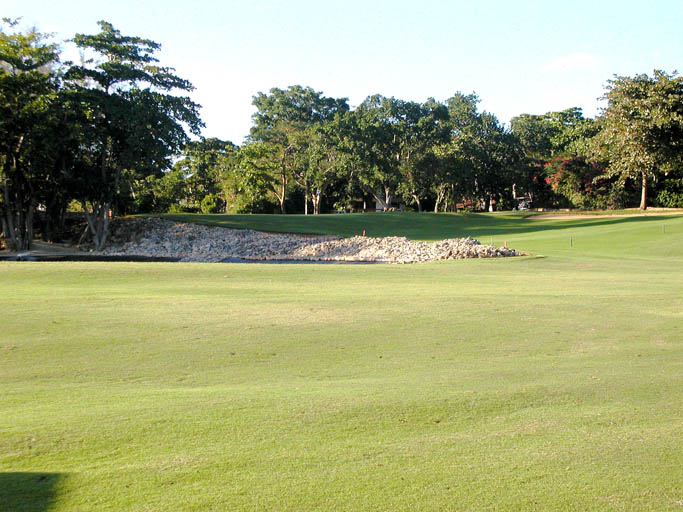
After the round is over, there is always a strong urge to have another go at the course – it always feels like there was a better score to be had out there. The joy of the course is to try again and again to find that elusive way to play and score better on the course.
The End







